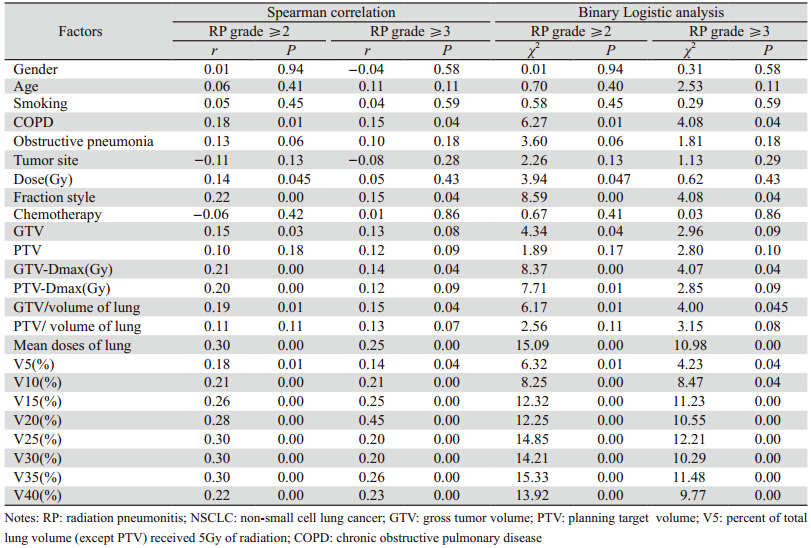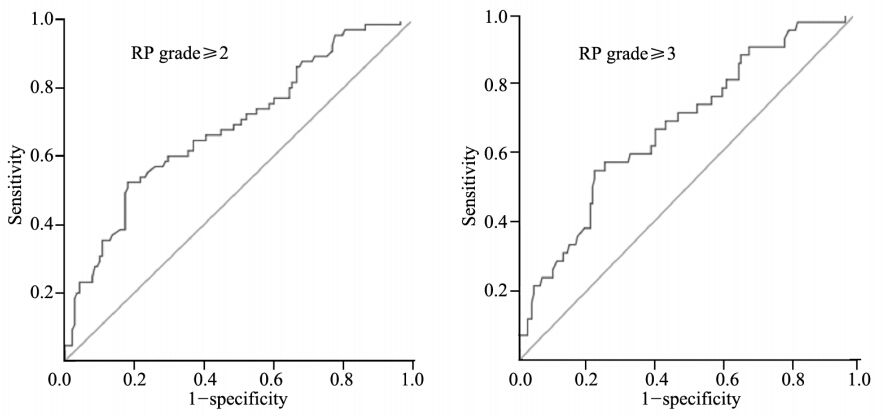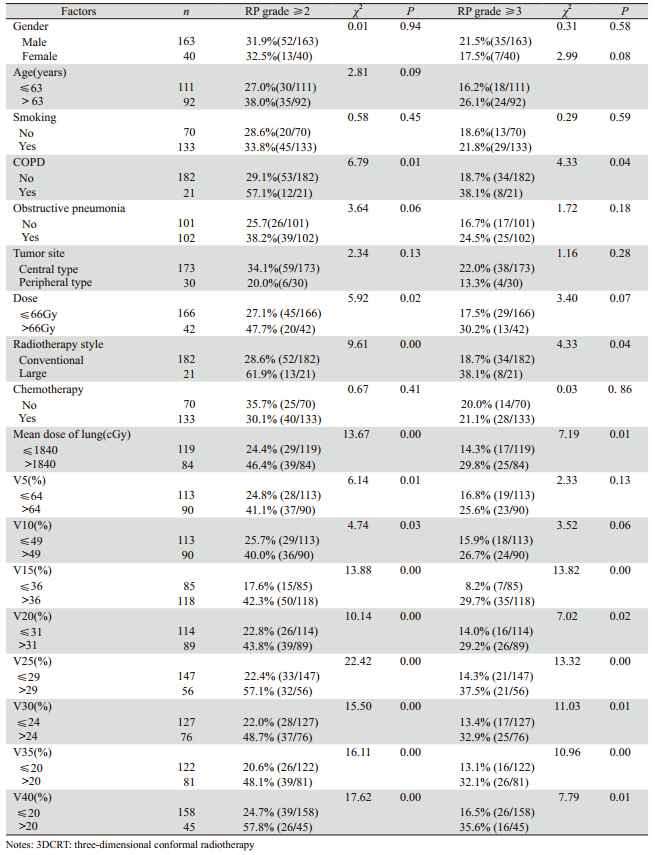| [1] |
Rodrigues G, Lock M, D’Souza D, et al. Prediction of radiation pneumonitis by dose-volume histogram parameters in lung cancer--a systematic review[J]. Radiother Oncol, 2004, 71(2):127-38.
|
|
| [2] |
Kim M, LeeJ, Ha B, et al. Factors predicting radiation pneumonitis in locally advanced non-small cell lung cancer[J].Radiat Oncol J, 2011, 29(3): 181-90.
|
|
| [3] |
Palma DA, Senan S, Tsujino K, et al. Predicting radiation pneumo nitis after chemoradiation therapy for lung cancer: an international individual patient data Meta-analysis[J].Int J Radiat Oncol Biol Phys, 2013, 85(2): 444-50.
|
|
| [4] |
Fay M, Tan A, Fisher R, et al. Dose-volume histogram analysis as predictor of radiation pneumonitis in primary lung cancer patients treated with radiotherapy[J].Int J Radiat Oncol Biol Phys, 2005, 61(5): 1355-63.
|
|
| [5] |
Fu HY, Lu B,Xu BQ, et al. Prospective study of lung V5 and V10 in predicting radiation-induced lung injury in advanced nonsmall-cell lung cancer treated with three-dimensional conformal radiation therapy[J]. Zhonghua Fang She Zhong Liu Xue Za Zhi, 2009, 18(6): 439-42. [付和谊, 卢冰, 徐冰清, 等. Ⅲ+Ⅳ期非小细胞肺癌三维适形放疗正常肺V5、V10预测放射性肺损伤前瞻性临床研究[J]. 中华放射肿瘤学杂志, 2009, 18(6): 439-42.]
|
|
| [6] |
Wang J, Qiao XY, Cao YK, et al. Analysis of correlated factors of radiation pneumonitis after three-dimensional conformal radiotherapy for non-small cell lung cancer[J].Zhongguo Zhong Liu Lin Chuang, 2009, 36(19): 1086-9. [王静, 乔学英, 曹彦坤, 等. 非小细胞肺癌三维适形放疗放射性肺炎发生的多因素分析[J]. 中国肿瘤临床, 2009, 36(19): 1086-9.]
|
|
| [7] |
Zhuang TT, Liu Q, Zhang L, et al. Risk factors of acute radiation pneumonitis in patients with non-small cell lung cancer after concurrent three-dimensional conformal radiotherapy and chemotherapy [J]. Zhonghua Fang She Zhong Liu Xue Za Zhi, 2009, 18(6): 443-7. [庄婷婷, 柳青, 张黎, 等. 非小细胞肺癌三维 适形放疗同期化疗后急性放射性肺炎发生因素分析[J].中华放射肿瘤学杂志, 2009, 18(6): 443-7.]
|
|
| [8] |
Zhu XZ, Wang LH, Wang YJ, et al. Risk factors of radiation pneumonitis in stage III non-small cell lung cancer treated with three-dimensional conformal radiotherapy[J]. Zhonghua Fang She Zhong Liu Xue Za Zhi, 2007, 16(6): 421-8. [朱向帜, 王绿化, 王 颖杰, 等. 三维适形放疗局部晚期非小细胞肺癌的放射性肺炎 风险因素研究[J]. 中华放射肿瘤学杂志, 2007, 16(6): 421-8.]
|
|
| [9] |
Wang DQ, Zhang J, Li BS, et al. Dose-volume histogram parameters for predicting radiation pneumonitis using receiver operating characteristic curve[J]. Zhonghua Fang She Yi Xue Yu Fang Hu Za Zhi, 2012, 32(5): 505-8. [王冬青, 张建, 李宝生, 等. 剂量体积直方图参数对放射性肺炎的工作特征曲线预测分析[J]. 中华放射医学与防护杂志, 2012, 32(5): 505-8.]
|
|
| [10] |
Yom SS, Liao Z, Liu HH, et al. Initial evaluation of treatmentrelated pneumonitis in advanced-stage non-small-cell lung cancer patients treated with concurrent chemotherapy and intensity-modulated radiotherapy[J].Int J Radiat Oncol Biol Phys, 2007, 68(1): 94-102.
|
|
| [11] |
Shi A, Zhu G, Wu H, et al. Analysis of clinical and dosimetric factors associated with severe acute radiationpneumonitis in patients with locally advanced non-small cell lung cancer treated with concurrent chemotherapy and intensity-modulated radiotherapy[J]. Radiat Oncol, 2010, 5: 35.
|
|
| [12] |
Oh D, Ahn YC, Park HC, et al. Prediction of radiation pneumonitis following high-dose thoracic radiation therapy by 3 Gy/fraction for non-small cell lung cancer: analysis of clinical and dosimetric factors[J].Jpn J Clin Oncol, 2009, 39(3): 151-7.
|
|
| [13] |
Jin H, Tucker SL, Liu HH, et al. Dose-volume thresholds and smoking status for the risk of treatment-relatedpneumonitis in inoperable non-small cell lung cancer treated with definitive radiotherapy [J].Radiother Oncol, 2009, 91(3): 427-32.
|
|
| [14] |
Wang S, Liao Z, Wei X, et al. Analysis of clinical and dosimetric factors associated with treatment-relatedpneumonitis (TRP) in patients with non-small-cell lung cancer (NSCLC) treated with concurrent chemotherapy and three-dimensional conformal radiotherapy (3D-CRT)[J].Int J Radiat Oncol Biol Phys, 2006, 66(5): 1399-407.
|
|
| [15] |
Wang J, Wang P, Pang QS, et al. Clinical and dosimetric factors associated with radiation-induced lung damage in patients with non small cell lung cancer treated with three-dimentional conformal radiotherapy[J]. Zhonghua Fang She Zhong Liu Xue Za Zhi, 2009, 18(6): 448-51. [王静, 王平, 庞青松, 等.非小细胞肺癌三维适形放疗放射性肺损伤临床及剂量学因素分析[J]. 中华放射肿瘤学杂志, 2009, 18(6): 448-51. ]
|
|
| [16] |
Wang J, Zhang TT, He ZC, et al. Severe acute radiation pneumonitis after concurrent chemoradiotherapy in non-small cell lung cancer[J]. Zhonghua Fang She Zhong Liu Xue Za Zhi, 2012, 21(4): 326-9. [王谨, 庄婷婷, 何智纯, 等. 非小细胞肺癌同期放化疗后重度急性放射性肺炎的预测因素[J]. 中华放射肿瘤学杂志, 2012, 21(4): 326-9.]
|
|
| [17] |
Wang D, Li B, Wang Z, et al. Functional dose-volume histograms for predicting radiation pneumonitis in locally advanced nonsmall cell lung cancer treated with late-course accelerated hyperfractionated radiotherapy[J].Exp Ther Med, 2011, 2(5): 1017-22.
|
|
| [18] |
Zhang XJ, Sun JG, Sun J, et al. Prediction of radiation pneumon itis in lung cancer patients: a systematic review[J].J Cancer Res Clin Oncol, 2012, 138(12): 2103-16.
|
|
| [19] |
Dang J, Li G, Lu X, et al. Analysis of related factors associated with radiation pneumonitis in patients with locally advanced nonsmall-cell lung cancer treated with three-dimensional conformal radiotherapy[J].J Cancer Res Clin Oncol, 2010, 136(8): 1169-78.
|
|
| [20] |
Kong FM, Hayman JA, Griffith KA, et al. Final toxicity results of a radiation-dose escalation study in patients with non-smallcell lung cancer (NSCLC): predictors for radiation pneumonitis a nd fibrosis[J].Int J Radiat Oncol Biol Phys, 2006, 65(4): 1075-86.
|
|
| [21] |
Dang J, Li G, Ma L, et al. Predictors of grade ≥ 2 and grade ≥ 3 radiation pneumonitis in patients with locally advanced nonsmall cell lung cancer treated with three-dimensional conformal radiotherapy [J].Acta Oncol, 2013, 52(6): 1175-80.
|
|
| [22] |
Par ashar B, Edwar ds A, Mehta R, et al. Chemother apy significantly increases the risk of radiation pneumonitis in radiation therapy of advanced lung cancer[J].Am J Clin Oncol, 2011, 34(2): 160-4.
|
|
| [23] |
Br adley JD, Paulus R, Komaki R, et al. A r andomized phase Ⅲ comparison of standard-dose(60Gy)versus highdose(74Gy)comformal chemoradio+/- cetuximab for stage III nonsmall cell lung cancer: results on radiation dose in RTOG 0617[J]. J Clin Oncol, 2013, 31(suppl;abstr 7501).
|
|




 2014, Vol. 41
2014, Vol. 41
